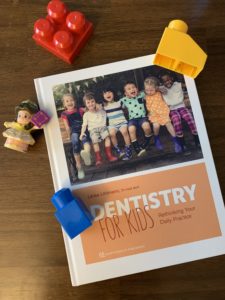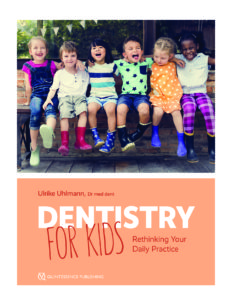Written by: Leah Huffman
Kids can certainly be a challenge. Ask any parent, teacher, or health care worker who interacts with them on a daily basis. Kids can be demanding, unpredictable, and sticky. But as pediatric dentist Ulrike Uhlmann points out, “They are also the most genuine and most grateful patients you can imagine. No ‘thank you’ or warm handshake will leave you quite as happy as the melted bar of chocolate shyly conjured out of a child’s backpack or the picture that a little patient has painted and proudly presents to you.” Whether they are chatty or shy, squirrelly or serious, kids can be the most appreciative and trusting of patients in the dentist office. And while not all dentists need to become pediatric dentists, all dentists are obliged to deal with or indeed treat their young patients responsibly. Here are 5 tips for increasing compliance with kids, curated from Dr Uhlmann’s new book, Dentistry for Kids: Rethinking Your Daily Practice.
“No ‘thank you’ or warm handshake will leave you quite as happy as the melted bar of chocolate shyly conjured out of a child’s backpack or the picture that a little patient has painted and proudly presents to you.”
1. Create a child-friendly environment.
In consideration of your other patients and the sanity of your staff, opt against any toys that make noise, and consider the cleansability of any toys you plan to have available for tiny hands.
Children need to be engaged to feel comfortable in any public space. A waiting area with chairs and magazines will not cut it for most kids. But that doesn’t mean you need much. A table with paper and crayons, some child-appropriate books (good ones, not the cheapest you can find!), and some building blocks or pretend play toys are sufficient. Just make sure they are placed at a level where the child can see them as soon as they enter your practice. Any pictures or wall decals should also be at child level. If space is a concern, wall-mounted drawing boards or magnetic toys can be a good alternative. In consideration of your other patients and the sanity of your staff, opt against any toys that make noise, and consider the cleansability of any toys you plan to have available for tiny hands.
In the treatment area, a photo or painting on the ceiling can dually fascinate young children and distract older, anxious patients. It’s also a good idea to keep air freshener on hand to eliminate the typical smells of the dental practice, which can unsettle or frighten some children.
2. Know that not all kids are the same.
Every child is unique, and every child comes with a different personality, a different home life, and a different set of emotions. That being said, it’s important to decipher which type of pediatric patient you have sitting in front of you to determine how best to interact with them. Some younger children will cry for no apparent reason, and for these little ones it might be a good idea to speak very quietly to arouse their interest and therefore calm them down. For extra shy patients, you may need to allow them extra time to get comfortable and gain the confidence to come out from behind mom or dad. It can often help with these patients to perform an examination first on a parent; while doing so, ignore the child completely and audibly communicate all findings to the dental assistant (for example, “I’ve counted eight of mommy’s teeth and they are lovely and sparkling”). Offering a prize to the parent for their cooperation may be enough to tempt the child to volunteer for or at least accept examination themselves. Know-it-alls can be a particular challenge, but straightforward conversation and blunt answers to questions can often nip any difficulty in the bud.
Perhaps the most difficult type of patient is the overly spoiled child or child of helicopter parents. These children are often petulant and confrontational, and the parents will often defend their child’s poor behavior. The best tools in this case are voice control (speaking calmly and quietly when the child is cooperating and more loudly and assertive when cooperation wanes) and clear rules expressed directly to the child (“This is my practice and in here we work by my rules. I’d like you to be nice to me and everyone working here—just as nice as you expect me to be. I cannot keep your teeth healthy if you disrespect me and mess with all of my instruments.”).
3. Respect personal space and use child-appropriate language.
A stuffed animal or toy can often act as a neutral mediator to encourage small children to allow the dentist to encroach on their personal space, and it can be used for demonstration purposes to allay any fears.
Children have the right to their personal space as much as any adult does, and dentists need to respect that. Any invasion to this space, whether with movements or even verbally, can result in anxiety or aggression because the child no longer feels safe and secure. Of course any dental examination or treatment requires some invasion of this personal space, so the trick lies in shrinking it enough and making the patient comfortable enough to allow that invasion. First of all, dentists and assistants should maintain an open smile, a calm manner, and nonjerky movements and read the signals coming from the child. Some children may require more time than others to get acquainted and let their guard down. A stuffed animal or toy can often act as a neutral mediator to encourage small children to allow the dentist to encroach on their personal space, and it can be used for demonstration purposes to allay any fears.
In addition, child-appropriate language must be used at all times. This means short sentences with concrete words that children can understand, like “tooth feeler” instead of “probe.” While a child’s imagination can certainly make some things seem scary, the dentist can also tap into it to change the narrative and make an otherwise-threatening object seem fun (for example, by creating a story around a given treatment step). It is also a good idea to avoid the word “okay” at the end of a sentence, because it can confuse children into thinking they are being asked a question, which is a problem if they answer with “no.”
4. Work with the child and PRAISE them when they cooperate.
A child is not a little adult, and it is important to remember that children have a MUCH shorter attention span than adults. Dr Uhlmann expects an attention span of about 5 minutes per year of life, which doesn’t add up to much for a 2- or 3-year-old sitting in the dental chair. Ask questions that engage their curiosity (“How many teeth do you think you have in there?”) to keep them attentive, and use whatever works for a given patient. For some children, a favorite stuffed animal or toy can make all the difference in the dental chair. It can be used for demonstration and bring comfort when the child gets anxious. For others, using their own toothbrush can make examination less scary, or watching an older sibling go first.
Even simple things like sitting in the dental chair should be acknowledged with praise to encourage the child to continue with the examination or treatment.
Most importantly, never underestimate the power of praise. Like adults, the more confidence a child feels, the better they will feel about themselves and their immediate circumstances. Offer praise in the form of positive words, high fives, or ringing of a special bell to let the child know that they are doing a good job listening and following instructions. Even simple things like sitting in the dental chair should be acknowledged with praise to encourage the child to continue with the examination or treatment. Even if the session does not go well, try to find something worthy of praise, like their willingness to open their mouth and let the dentist sneak a peek.
5. Make it fun!
“It’s all about fun! The more fun a kid has in your office, the more compliant he or she will be.”
As stated in Dr Uhlmann’s book, “It’s all about fun! The more fun a kid has in your office, the more compliant he or she will be. Make sure you have fun toys, you hand out cool prizes, and you engage the child in fun ways.” There is no limit to how creative you can be in your practice to make things fun for kids. From coloring contests to competitions for who can count the most clicks during anesthesia administration to ringing a bell when treatment is finished, opportunity is all around to make the dental practice a place of fun instead of fear or frustration.
Last but not least, be generous with prizes. Kids love free stuff, especially when they feel they’ve earned it, so they should be awarded a little prize at the end of each session.
Finally, be patient.
As humorist Franklin P. Jones once said, “You can learn many things from children. How much patience you have, for instance.” Whether it’s the screaming baby, the sticky-handed schoolchild, or the eye-rolling teenager, try to be patient. You may just get rewarded with a crumpled candy bar or perfect little-kid hug.

Ulrike Uhlmann, Dr med dent, studied dentistry at Leipzig University from 2005 to 2010. Even during her studies she showed a keen interest in children’s dentistry. After her examinations in 2010, she worked in Halle/Saale for 4 years, during which time she learned about and came to love the whole gamut of pediatric dentistry. Interdisciplinary work with midwives, pediatricians, and speech therapists was and is a cornerstone of her professional ethos. At present she works on the staff of a family dental practice in Leipzig. As a speaker, she is also involved in the continuing professional development of midwives, speech therapists, educators, and other related professional groups in the field of pediatric dentistry. Together with a Leipzig midwives practice, she has also launched a parents workshop where relevant topics concerning children’s oral health are explained to pregnant women and parents, raising their awareness. She is married and has four children.
Dentistry for Kids: Rethinking Your Daily Practice
Ulrike Uhlmann
The practice of pediatric dentistry requires a broad knowledge of dentistry, orthodontics, nutritional sciences, and last but not least, psychology. The goal is to enable our young patients to live with the healthiest teeth possible, and this involves understanding how to embrace the opportunity, challenge, and responsibility of ensuring an ideal start for even the tiniest of our patients. This book presents the fundamentals of pediatric dentistry and explains how to incorporate them into an existing dental practice. Because parents are a crucial part of the equation, particular focus is given to educating and managing parents to be the best advocate for their children’s oral health. While the book is a useful reference for everyday practice in terms of examination, diagnostics, and findings, it goes further to include tips on how to create a child-friendly environment, how to communicate with young patients, and how to handle difficult situations with uncooperative patients or parents. The second half of the book is given over to treatment considerations, spanning from preventive treatment like fluorides and sealants to filling and crown therapy. This final chapter also includes sections on antibiotic use, managing trauma, sedation, and other particular challenges in everyday practice. This book is an essential resource for anyone working with kids in dentistry.
200 pp; 187 illus; © 2020; 978-1-64724-013-4 (B0134)
Contents
1. Introduction and Basics
2. Successful Communication with Kids and Parents
3. Educating Parents: Oral Hygiene and Prophylaxis
4. Dental Examination and Tips for Increasing Compliance
5. Diagnostics in Pediatric Dentistry
6. Findings
7. Treatment Considerations and Approaches
Epilogue


